Riley James Practicum in Anthropology Dr. Terry G. Powis May 9, 2022
Introduction
The Mississippian Period was a cultural era in the Eastern United States that lasted from around 1000 CE to 1550 CE (Powis et al. 2021). It was characterized by great cultural interconnectedness where art and trade flourished. While we have many examples of the art created during the Mississippian Period, we do not have much information on precisely what went into its creation. Unfortunately, there are no firsthand records of the rituals and practices of Mississippian peoples from their own perspective, so we are left to extrapolate from the archaeological record and what was recorded after European contact. This can be achieved through excavation and analysis of features and artifacts. Mound sites such as Etowah and Cahokia are the archetypal examples of this, however they only illustrate how the elite of society may have lived. Fortunately, a Mississippian house outside these political and population centers was discovered and excavated at the Cummings site in Northwest Georgia (Figure 1). It is from this site that artifacts potentially related to art production were found and studied for the purposes of this research. From the analysis of these artifacts and comparisons with other Mississippian Period sites, I hope to determine if the residents of the Cummings site were artists and in what capacity.
Terminology
Words and terms often hold numerous concepts to different people based on context and field of study. Art is the key word in this research, and its exact definition is the topic of endless debate in anthropology and other disciplines. In the course of this research, the operative definition has been the following: any material culture created for any reason that is not strictly utilitarian. Common examples of finished physical art products include decorated pottery, paintings, sculptures, figurines, reliefs, and decorated plaques or plates. This is not to say cultural acts such as dance are not art, but they are not directly relevant to this research.
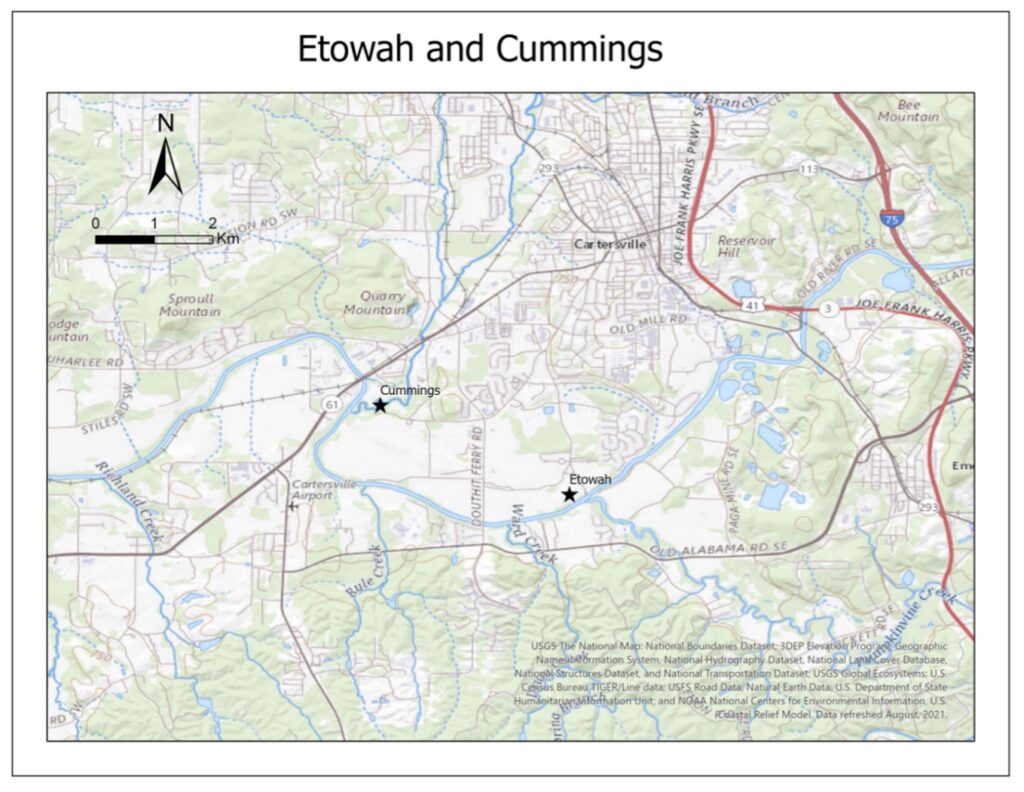
Figure 1. Map displaying the distance and relative positions of the Cummings site and the Etowah Indian Mounds in Georgia. Image courtesy of Dr. Terry G. Powis.
Background
In an archaeological and historical context, Mississippian refers to the cultural period lasting from approximately 1000 CE to 1550 CE. It occurred over the area of the Midwestern and Southeastern United States and is named after the Mississippi River Valley where it was first identified. Socio-politically, the period exhibited a system of strong social hierarchy whereby paramount chiefdoms exerted control over vast subservient territories. Elites such as chiefs and their families held spiritual and religious power within their society and used that cultural standing to gain and use political, military, and economic power. Due to their spiritual connections, they were responsible for conducting and directing religious rituals and practices. As befitted their status in society, the elites were permitted much greater access to resources than the commoners they ruled over. They lived in larger settlements with mounds and palisades and had the necessary influence to facilitate the long-distance trade of goods and materials. However, elites and commoners were very similar when it came to putting roofs over their heads. Despite the difference in status, they would have lived in homes of a similar construction and style. The walls were made of woven cane, or wattle, and were covered with sunbaked clay, or daub (Figure 2). They had a roof of thatch with a central hole to allow smoke from the underlying hearth to escape. Benches lined the interior of the walls, and the floor was simply packed dirt. Size would vary, but most buildings would have measured between twelve and thirty feet on a side (King 2021). The extensive trade network of the Mississippian Period is a part of what is called the Southeastern Ceremonial Complex (SECC). The SECC was a cultural and spiritual exchange network covering the whole of the Mississippian world that is largely defined by its artifacts related to artistic depictions of religious or cultural motifs and its artifacts related to rituals carried out as part of their beliefs. These include, but are not limited to, engraved shell, stone maces, copper plates, and a wide variety of ceramics. The most notable themes of the SECC are war, fertility, and ancestor worship. Because of their status within society, elites were most often the ones associated with these artifacts, as they had an innate connection to the spiritual (Bense 1996, 68-69). The height of the period, and the SECC, was during the Middle Mississippian sub-period, which lasted from approximately 1100 to 1350 CE. It was during this time that most paramount chiefdoms, the largest and most powerful chiefdoms, reached their maximum extent. A few examples include Moundville in Alabama, Cahokia in Illinois, and Etowah in Georgia. Cahokia was the largest Mississippian chiefdom, and often serves as the example to which other Mississippian sites are compared. In terms of material culture, the period has a number of unique ceramic styles, as well as a relatively higher number of artifacts such as copper plates and stone palettes compared to other periods (Bense 1996, 56-57). Of particular interest to this research is palette artifacts, which have been found as part of wrapped or unwrapped bundles in burials or simply discovered during excavations at Mississippian sites across the region. The majority of these palettes, otherwise referred to as discs, are round with flat tops and flat or convex bottoms, with only a few rectangular examples being known. Sandstone, limestone, shale, and slate are among the materials of which they are made. A number of them feature engravings on their top and sometimes bottom surfaces or notched sides, and sometimes both. They are frequently found with mineral residue on their surface and, most often in burials, are sometimes found in close proximity to pigment materials such as hematite, graphite, and galena, which can be used to make red, black, and white paint, respectively. It is likely that these palettes were used in the process of mixing and preparing paints, an activity that would have been a ritual as part of the SECC. They may have also served as mobile altars or centerpieces of ritual (Steponaitis 2011, 81-102; Wright 2016, 121-133, 234-254) In Georgia, the Mississippian Period is often discussed in reference to what was going on at Etowah at the time. During the Early Mississippian Period, Etowah was not much more than a modest settlement with a couple small mounds. By the end of the Early Mississippian Period, the site was abandoned. It was in the beginning stages of the Middle Mississippian Period that Etowah exploded into prominence, with its population and development growing rapidly. Social stratification reached an all-time high and elite burials with ample grave goods became commonplace. Raw materials and artifacts were imported from across the Mississippian world and included in the burials, shell from the Gulf Coast in particular. However, by the end of the Middle Mississippian Period, Etowah was quickly abandoned and not reoccupied until shortly before European contact. Politically, there is evidence that Etowah’s rapid rise and the maintenance of the social hierarchy was rooted in the elite’s ability to direct the trade of exotic goods and materials to the area. This access cemented their positions through monopoly and may have also contributed to the Middle Mississippian collapse. Of note, is that Etowah’s development sequence differs greatly from the sites of Cahokia and Moundville, which rose and fell over extended periods of time and were continuously occupied (King 2001, 1-9; Larson 2021). The height of Etowah (and most of its existence as the capital of a paramount chiefdom) coincided with the occupation of the Cummings site in Cartersville, GA, where the artifacts studied in the course of this research originated. The land the site is on belongs to the Walnut Grove Plantation, who has given Dr. Terry G. Powis permission to excavate and hold annual archaeology field schools there. It is around three kilometers to the northwest of the Etowah mounds and belongs to the Etowah Valley Archaeological District. Nearby to the site is the Etowah River and its tributary, Pettit Creek, giving the residents easy access to its resources. Ample water availability also serves to make the land quite fertile for farming. On this site is a Middle Mississippian house that has been excavated and was determined to have burned down. It is unknown what may have caused the fire that destroyed the structure and left a blackened floor and several collapsed posts (Figure 3). The wood in the burned posts allowed for radiocarbon dating that determined the time of the house’s destruction to be somewhere between 1260 and 1300 CE. Next to the excavation of the prehistoric house is a dilapidated historic house dating to the early 20th century. It has since been reduced to a few sections of foundation, a chimney, and a root cellar. Historic artifacts are scattered about the site as well due in large part to the presence of the building. The historic and prehistoric houses are located in the wood line, next to active farmlands. Powis has used the Cummings site for archaeology field schools in association with Kennesaw State University for several years. Furthermore, the course of these field schools’ research Phases I, II, and III have been conducted in the Cultural Resource Management style. It was during the Fall 2020 iteration of the field school that the Middle Mississippian house was discovered, and initial excavations were conducted, as well as when the artifacts analyzed in this research were recovered (Powis et al. 2021). Several other artifacts such as pottery fragments and stone celts have been found on the house floor and are the topics of study in other research (Griffin 2022; McElrone 2022). Several archaeological units have been excavated outside the house as well. A large number of lithic materials were recovered from these units and studied in regard to their relation to the house (Tomko 2022).
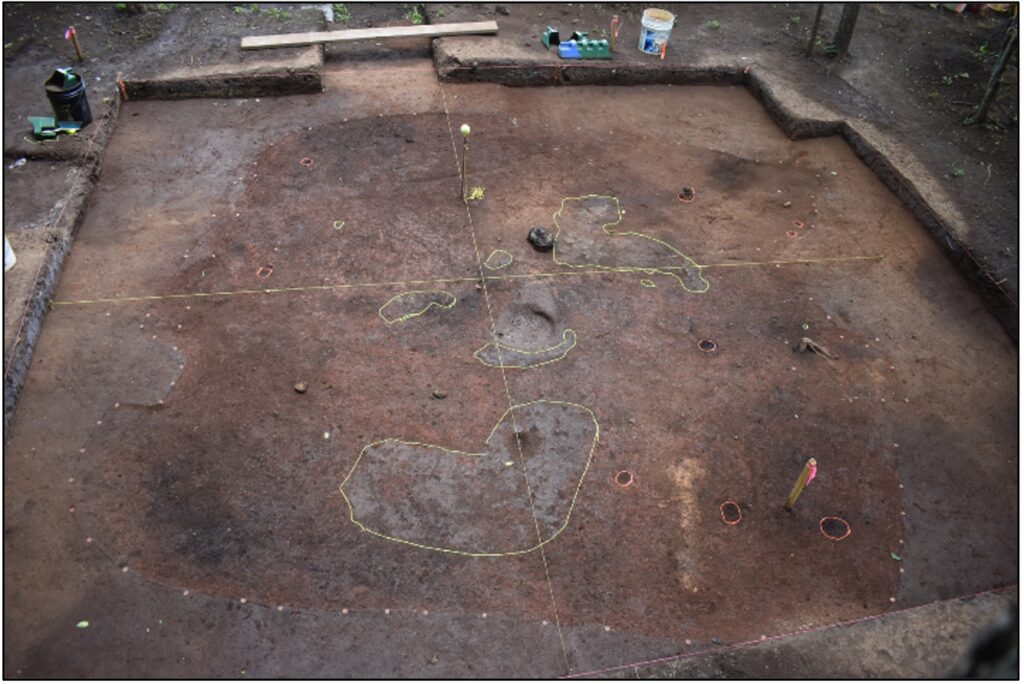
Figure 3. Picture of the excavated prehistoric house at the Cummings site. Image courtesy of Dr. Terry G. Powis.
Methodology
This research began by looking at the initial assemblage of artifacts arranged by Powis’s lab assistant Isabella Rosinko and determining whether or not they were relevant. The initial assemblage consisted of the following thirteen finds: one chunk of specular hematite, one chunk of graphite, two styluses, two palette fragments, and seven fragments of mica sheets. Following this, the rest of the artifacts recovered from the house floor were studied to determine if they were relevant to the research at hand. From this assessment, one additional artifact was put into the collection of items potentially related to art production: a stone spatula. Using a ruler and digital calipers, dimensional measurements were taken of all the artifacts. Two scales were used to measure the mass of the artifacts: an Ohaus digital scale for smaller objects and a Skylite digital suitcase scale was used for larger ones. Isabella Rosinko had created a catalogue of the finds from the Cummings site which was modified in the course of this research to account for the new measurements and information. Within this catalogue, each artifact was assigned an identification number and provenience number. Below is a list of each artifact and
| Artifact Number | Provenience Number | Description | Material |
| 6 | 21.1.NE.6 | Spatula | Slate |
| 7 | 21.1.NE.7 | Mineral chunk | Graphite |
| 8 | 21.1.SW.8 | Mineral chunk | Specular hematite |
| 9 | 21.1.NW.9 | Pointed stylus | Metavolcanic stone |
| 10 | 21.1.SE.10 | Beveled stylus | Metavolcanic stone |
| 17 | 21.1.SE.17 | Mica fragments | Mica (muscovite) |
| 18 | 21.1.SE.18 | Mica fragments | Mica (muscovite) |
| 19 | 21.1.NE.19 | Mica fragment | Mica (muscovite) |
| 20 | 21.1.SW.20 | Mica fragments | Mica (muscovite) |
| 21 | 21.1.SE.21 | Mica fragments | Mica (muscovite) |
| 22 | 21.1.SE.22 | Mica fragments | Mica (muscovite) |
| 23 | 21.1.SE.23 | Mica fragments | Mica (muscovite) |
| 38 | 21.1.SW.38 | Palette corner piece | Reddish sandstone |
| 39 | 21.1.SW.39 | Palette corner piece | Reddish sandstone |
how they have been identified (Table 1). Provenience numbers were created by listing the year the object was excavated, the feature number where it was found, the quadrant or level from which it came, and its artifact number, all separated by periods. As these provenience numbers were created, new labels were created for each artifact to be included in its storage bag. Next, photographs were taken of all the artifacts individually and as a total assemblage. A Nikon D3400 was used alongside a photo stand to take the photographs. A number of the photographs taken were of poor quality, and better ones were taken later. The actual analysis began with the use of a low powered microscope to closely inspect each artifact’s surface. Upon initial inspection, the minerals and mica did not seem to reveal much of note, while the palette and styluses had clear signs of wear and staining. It was noticed that the stains on the palette contained metallic flakes, so a pick was used to manipulate them and determine if they were residue or a part of the palette’s own material makeup. The flakes lifted easily, and it was noticed that they bore a striking resemblance to surface of the specular hematite chunk. The stylus artifacts had black stains of indeterminate makeup or origin around their distal tips. The graphite and specular hematite were initially misidentified as galena. This was discovered during an experiment to see what the residue would look like when they were scraped across sandstone. At first, small streaks were made on the edge of the palette artifacts. It was immediately obvious that they were different materials when the streaks they left were totally unalike. After this revelation, a streak test was done to compare the two minerals. A pencil’s lead was used as a control. What would become known as specular hematite left behind a crumbly red streak that did not cling well to surfaces, and the material that would become known to be graphite left slightly metallic black streaks that were near identical those left by the pencil. Example samples of each mineral were then looked at to compare and further confirm that the mineral types had been narrowed down. After the minerals compositions were confirmed, further experiments were conducted to determine if the residue on the palettes was left by graphite or specular hematite. Both minerals were scraped across a small piece of an unrelated sandstone palette in an attempt to leave a stain or residue large enough to analyze and compare to those left on the palette artifacts from the Cummings site.
Results
In this section, each artifact type will be discussed individually, including both quantitative and qualitative data. The types are broken-down into the sandstone palette, the specular hematite, the graphite, the styluses, the spatula, and the mica. The experiment results will be discussed as well.
Sandstone Palette
This group of artifacts consists of two pieces of a single palette that mend together. A significant portion of the palette is missing, and it is unknown where the rest of it may be. Both pieces are tabular and measure from 1.1 to 1.3 centimeters thick throughout. Artifact 38 measures 11.9 by 12 centimeters at the longest and has mass of 305.7 grams. Artifact 39 measures 16.2 by 12.8 centimeters and has a mass of 403 grams. When mended, the full length is 24.7 centimeters (Figures 4). Due to the breakage and missing portion, it is unknown if the complete palette was square or rectangular. A mineral composition analysis is necessary to be certain, but the material seems to be an iron-rich sandstone, contributing to its red color. Both pieces have significant strains or residues on their surfaces. Under the microscope, metallic flakes and a yellow and a black residue are clearly visible (Figure 5). The flakes lifted easily with the use of a metal pick and the residue could be easily removed from the surface.
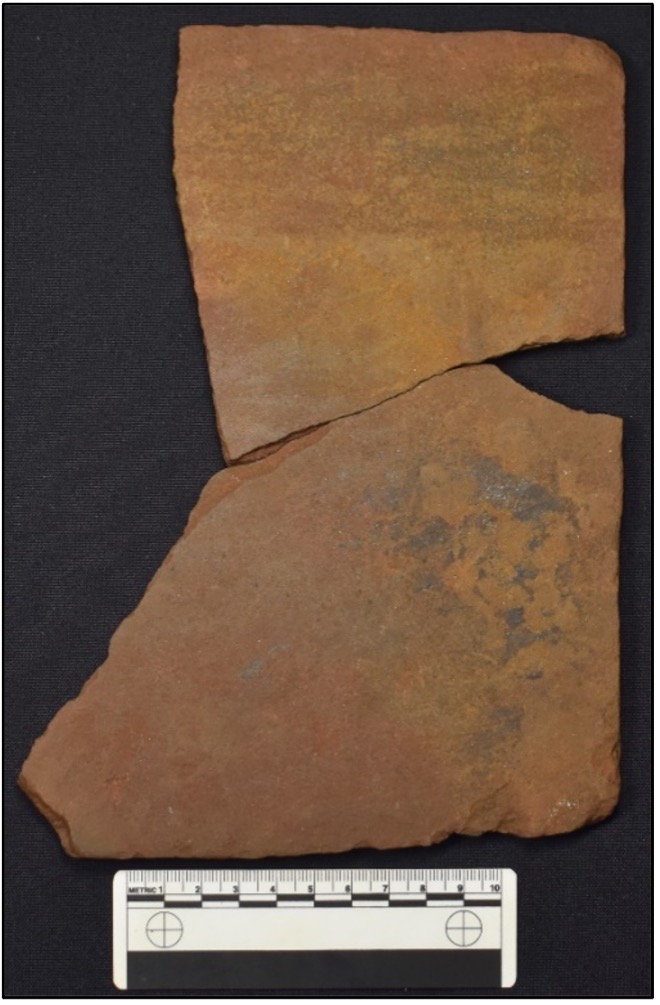
Figure 4. Both palette pieces mended together. The Majority of the stains and residue are on the displayed sides of both pieces.
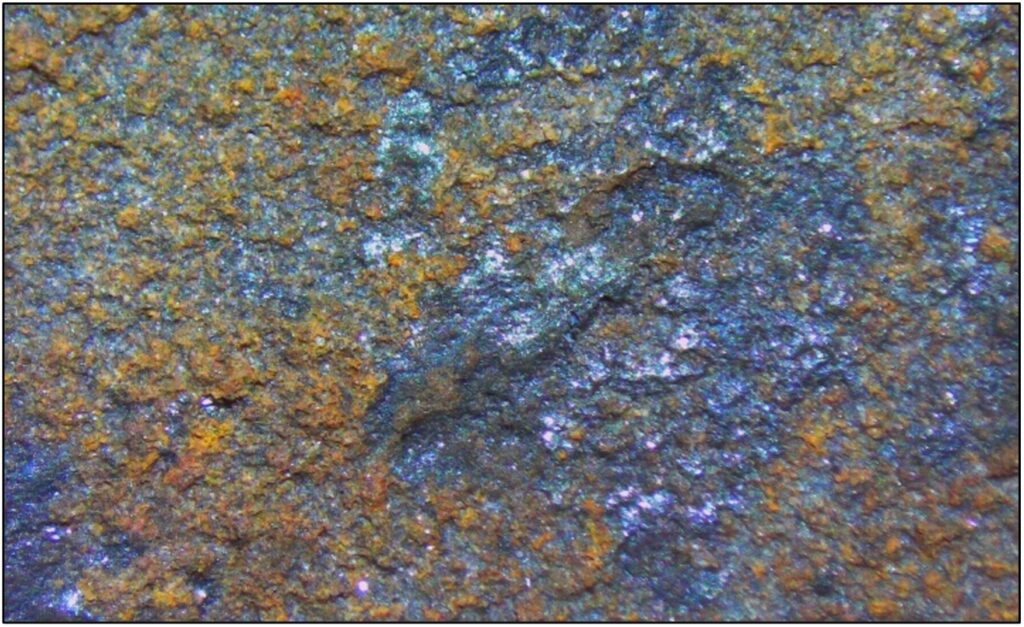
Figure 5. A 45x magnified view of the surface of the palette showing off the various stains and residue
Specular Hematite
The chunk of specular hematite measures 14.6 centimeters by 9.6 centimeters and has a mass of 1010 grams (Figure 6). At its thickest it is 4.08 centimeters. It has a mostly amorphous shape with a large depression in its center. Of note is that one of its sides has been worn down to a mostly flat surface. Its surface has many small indentations and valleys that when viewed closely reveal some type of yellowish material that has yet to be identified but is potentially some sort of yellow ochre, such as limonite, which is derived from hematite.
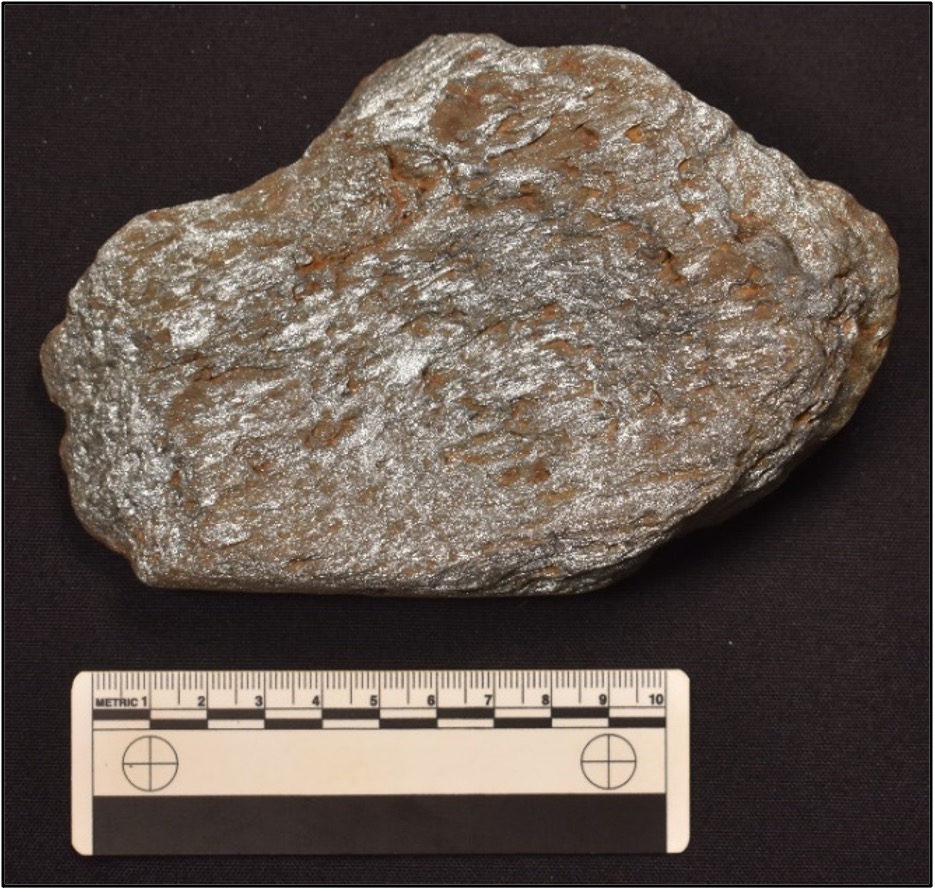
Figure 6. Photograph of the specular hematite.
Graphite
The graphite consists of a larger chunk and a much smaller chunk. The larger of the two measures 4.49 centimeters by 3.04 centimeters at the longest and has a mass of 32.2 grams (figure 7). The smaller piece is roughly triangular in shape while the larger piece is amorphous. Two of the sides on the larger piece are relatively smooth compared to the other sides, though here are no clear or obvious signs of wear. It appears that the graphite artifacts are not totally pure, and some other mineral or substance is interspersed throughout them.

Figure 7. Photograph of the graphite piece. Image courtesy of Dr. Terry G. Powis.
Styluses
The two stylus artifacts consist of a metavolcanic stone that bears a strong resemblance to andesite, though further material analysis would be required to determine this for certain (Figure 8). Artifact 9 is 3.02 centimeters long and 0.73 centimeters wide with a thickness of 0.39 centimeters. It has a mass of 1.2 grams and is roughly ovaloid with a sharply pointed triangular tip. Artifact 10 is 7.38 centimeters long and has a diameter of 0.53 centimeters. It has a mass of 3.7 grams and is roughly cylindrical with a round, beveled tip. Both artifacts are broken on their proximal ends with signs of wear on both the proximal and distal ends. Both styluses feature a light black stain around their tips. The stain is visible to the naked eye on Artifact 10, while the stain on Artifact 9 requires a microscope to be clearly visible. It is unknown what the origin of these stains may be, and it is unlikely that residue analysis could be performed without damaging the artifacts.
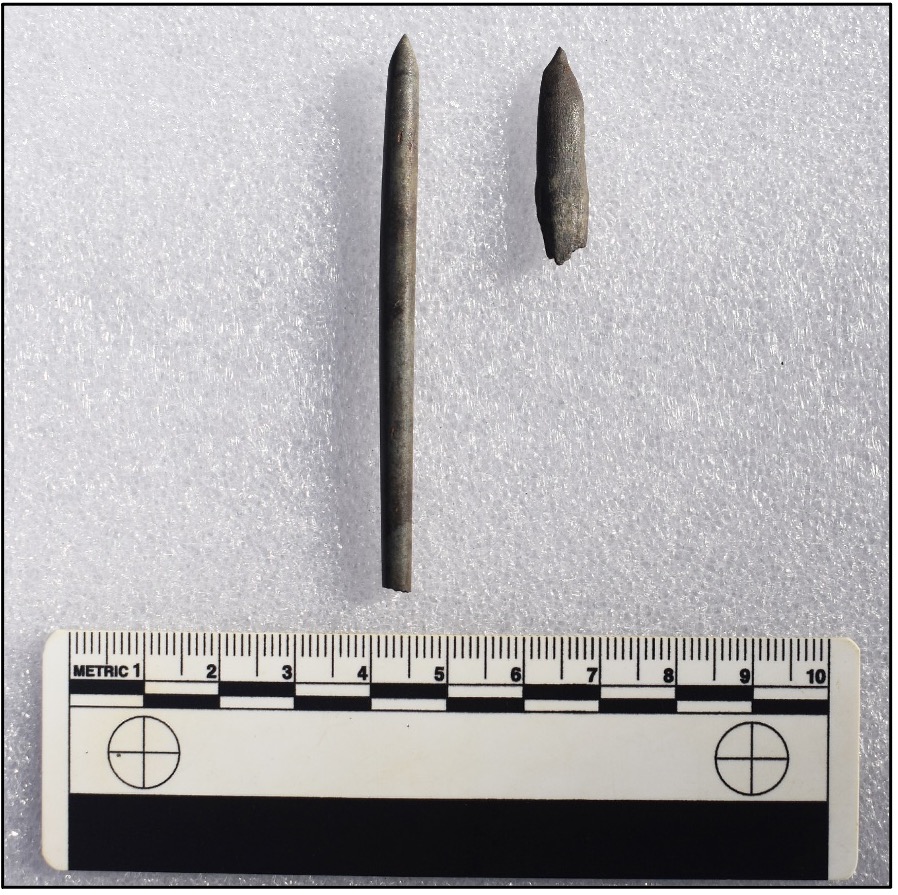
Figure 8. Photograph of the two stylus artifacts. Artifact 10 at left and artifact 9 at right. Image courtesy of Dr. Terry G. Powis.
Spatula
The spatula artifact is made of slate and measures 5.47 centimeters by 2.95 centimeters at the longest. It has a thickness of 0.63 centimeters and a mass of 13 grams. As is evidenced by its given moniker, it is spatulate in shape with a great degree of wear (Figure 9). Its handle was seemingly broken but was worn down smooth after the event. One of the flat surfaces is mostly smooth with shallow cuts and wear, while the other has an area of rough surface and features much more significant cut lines with many of them being parallel to one another. This side also has a streak of some kind of erosion running down its length. No stains or residue could be seen on the surface of the artifact, though this may be because it was washed very extensively prior to this research, much more so than any of the other artifacts.
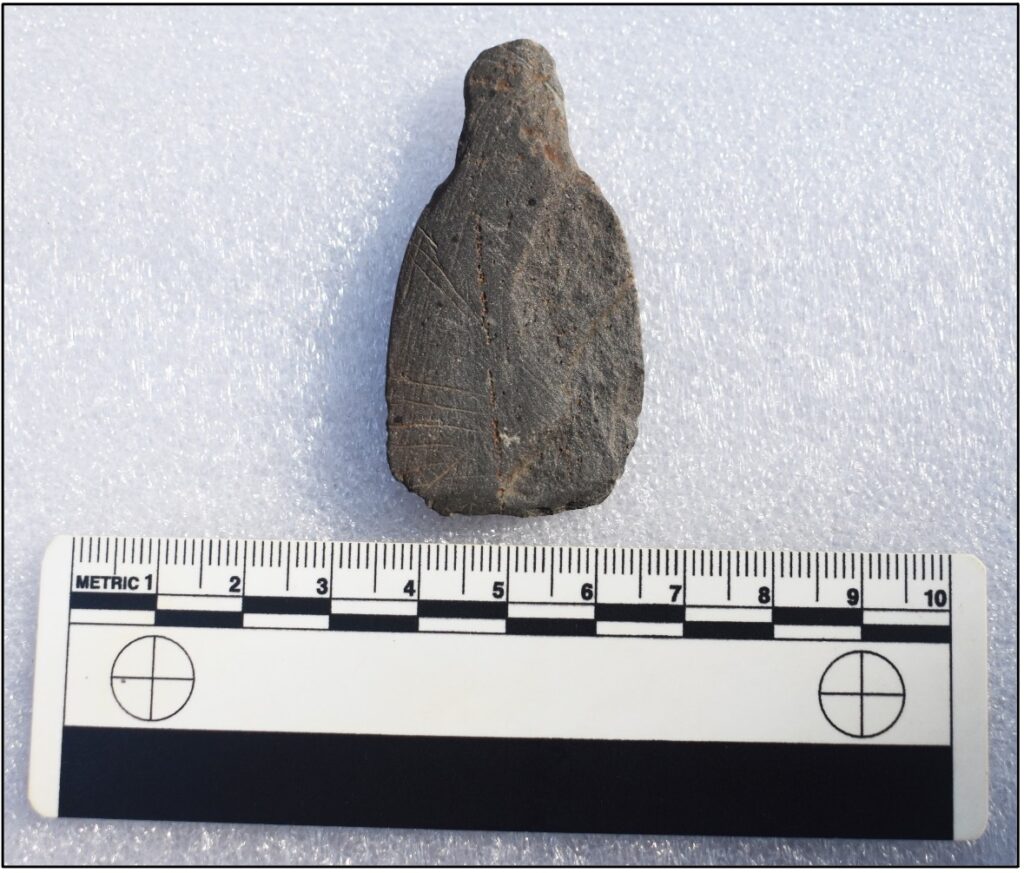
Figure 9. Photograph of the spatula artifact. Image courtesy of Dr. Terry G. Powis.
Mica
The mica found on the house floor consists of seven groupings of various amounts and appearance. Many pieces consisted of single glass-like sheets measuring 0.01 centimeters thick, while the most substantial piece consisted of several opaque sheets measuring 0.17 centimeters thick. The vast majority of the mica appears to have not been worked or otherwise modified in any way. A few of the pieces show potential signs of cutting or modification (Figure 10). Prior to the Mississippian Period was the Woodland Period, which is worth mentioning here because of its notable artistic products, particularly cut mica artifacts. The vast majority of this cut mica comes from Middle Woodland Hopewell tradition and features designs such as open hands and raptor talon. Despite being commonplace in this previous cultural era, there is no evidence that the production of mica art continued into the Mississippian Period.

Figure 10. Photograph of a selection of mica artifacts. Image courtesy of Dr. Terry G. Powis.
Experiment Results
The experiment involving scraping the minerals on the unrelated sandstone palette produced residues that, when analyzed under a microscope, are near identical to those on the palette artifact. This information combined with the similarity between the metallic flakes on the palette and the surface of the hematite has led to the conclusion that a hematite residue was certainly left on the palette and a graphite residue was also likely left on the palette. The experiment involving attempting to cut mica with a chert flake produced results that showed that mica can be easily and quickly cut by chert. Nearly every swipe of the flake cut through a layer of mica with no layer taking more than three swipes. It cut remarkably straight and with virtually no flaking or fracturing on the main body of the mica. One notable discovery was that a powder from where the mica was cut was getting caught between the layers and beginning to noticeably separate them. To alleviate this and avoid breaking the body of the mica, the cut edge was wetted and compressed. After drying, the experimental cut mica was compared under the microscope to the mica artifacts that appeared to have been modified, and they bore such a resemblance that it has been concluded that artifacts 19 and 20 were intentionally cut.
Discussion
The most important thing to consider when discussing the Cummings site’s Middle Mississippian house is its relation to Etowah. At a mere three kilometers away, nothing would have happened at Cummings that the paramount chief would not have known about. However, this distance also would mean that the residents of Cummings had a level of autonomy just greater than the commoners living within the urban area of Etowah, but still firmly under the control of the chief. There is no doubt that they would have been called to service frequently for matters of war or public labor. This proximity also would have potentially allowed foreign goods to enter the hands of the people of Cummings, though the societal dynamics of how this process might have occurred are not known for certain, as commoners would have much less sway in determining what goods went where. It also follows that the SECC would have been the core of the belief system of the Cummings site residents. Given its location within the fertile Etowah River Valley and its close proximity to a creek that feeds into the Etowah River, it is certain that Cummings was a hotspot of agricultural activity. It is likely that everyone participated in farming in some capacity, whether it be part-time or full-time. The artifacts present on the floor of the Cummings site house are strong evidence that art was being produced in some capacity. The palette with ample staining and mineral residue is perhaps the biggest indicator, and this being found alongside the very minerals that are likely on its surface reinforces this idea. Despite there being few to no examples to compare them to, the styluses with their stained tips and the spatula also point towards the production of art. There is little information to be gleaned from the mica though, as no finished products were present in the house and only a couple pieces showed signs of modification. While there is evidence that art production was occurring, there is no evidence at this point that it was occurring at a large-scale at the Cummings site. No finished art products were found on the floor, leaving little room for inferences to be made on how much art was being produced and where it was going. This does not necessarily mean the residents of the house were not dedicated specialists, but the low volume of artifacts does not point towards this. It is entirely possible that the residents were instead part-time specialists, farming at times and producing art at others. In this situation, it is likely that they would have made their art in a ritualistic capacity as part of the SECC. The palette artifact and pigment minerals in particular point towards this. Compared to the palettes found at major sites like Etowah and Moundville, the Cummings palette is crude and simple, as would be expected when comparing what commoners would have access to and what elites would have access to.
Further Research
There is still much to learn and many avenues to explore regarding the topic of art production during the Mississippian Period. Chemical and material analyses of the artifacts would bring crucial clarity to art production in this period. Confirming the stone used to create the styluses could help with sourcing their origin. Making certain that the mineral artifacts are in fact specular hematite and graphite would also be helpful, especially in regard to the palette artifact. Further confirmation is required to determine if the residue on the surface of the palette is the same as the minerals found in context with it. Going beyond what was found on the floor of the house, there simply needs to be more excavations of Mississippian Period houses. It is hard to make comparisons when there is little to compare to. There is a strong possibility that the Middle Mississippian house at Cummings is not in isolation. Further context for the site’s circumstances would allow more inferences to be made about the local social dynamics.
Conclusion
Based on all available evidence, the most likely conclusion to be drawn is that the residents of the Middle Mississippian house at the Cummings site were part-time specialists that created art for ritual purposes within the SECC. There is little to no evidence that they were producing works of art at a scale that would imply full-time specialization. The toolkit of a Mississippian Period artist would have certainly included a palette and minerals for creating paint. Less concrete is the styluses and spatula, as similar artifacts have not been found elsewhere, but they were at least in the toolkit of the residents of Cummings.
Acknowledgments
This research would not have been possible without the support of Kennesaw State University’s Department of Geography and Anthropology. Dr. Terry G. Powis is also thanked for the opportunity to conduct these analyses. Isabella Rosinko offered valuable assistance and advice.
Bibliography
Bense, Judith A. 1996 Overview of the Mississippian Stage in the Southeastern United States. Revista de Arqueología Americana, no. 10 (1996): 53–71. Griffin, Tristen 2022 Clay in the Homestead: A Ceramic Analysis of a Middle Mississippian House. Oral presentation at the annual Symposium of Student Scholars, Center for Teaching and Excellence, Kennesaw State University, April 19. King, Adam 2001 Long-Term Histories of Mississippian Centers: The Developmental Sequence of Etowah and Its Comparison to Moundville and Cahokia. Southeastern Archaeology 20, no. 1 (2001): 1–17. King, Adam 2021 Mississippian Period. Web article on New Georgia Encyclopedia. https://www.georgiaencyclopedia.org/articles/history-archaeology/mississippian-Period-overview/ Larson, Lewis 2021 Etowah Mounds. Web article on New Georgia Encyclopedia. https://www.georgiaencyclopedia.org/articles/history-archaeology/etowah-mounds/ McElrone, Devlin 2022 House of Rock: An Analysis of a Lithic Assemblage from an Early Wilbanks Phase House Floor. Poster presented at the annual Symposium of Student Scholars, Center for Teaching and Excellence, Kennesaw State University, April 19. Powis, Terry G., Jordan Farkas, Carl Etheridge, Kong Cheong, and Adam King 2021 The Cummings Site; Life on the Outskirts of Etowah. Paper presented at the 77th annual meeting of the Southeastern Archaeological Conference, Durham, NC, Oct. 26. Tomko, John 2022 Mississippian Lithics: Identifying Workshops in the Etowah River Valley. Poster presented at the annual Symposium of Student Scholars, Center for Teaching and Excellence, Kennesaw State University, April 19. Steponaitis, Vincas P., Samuel E. Swanson, George Wheeler, and Penelope B. Drooker 2011 The Provenance and Use of Etowah Palettes. American Antiquity 76, no. 1 (2011): 81–106. Wright, Henry T. 2016 Rethinking Moundville and Its Hinterland. Edited by Vincas P. Steponaitis and C. Margaret Scarry. 1st ed. University Press of Florida.
